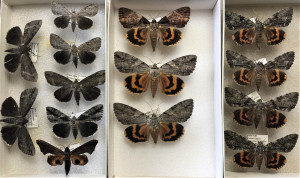|
|
Post by exoticimports on Sept 3, 2020 4:09:51 GMT -8
In all the posts from rayrard all I see is a grey no entry sign. Odd, me too. At approximately 03Sept20 8:00am I was looking at this thread on my phone and it was fine. At 8:08am on my computer I too get the grey no entry sign instead of a photo. Could be the hosting service? ETA: 8:19am, the no entry sign on rayrard's images is a valid URL, and it IS what you're seeing. Either his images were replaced or access is being denied. Chuck |
|
|
|
|
|
Post by exoticimports on Sept 3, 2020 4:16:21 GMT -8
A couple weeks ago John H reported that in his area, catocala were unusually scarce this year. Oddly, in Upstate NY the catocala are in banner numbers- they are in the garage, on the house, and flying during the day. Horrible things. Anyway, here's some ready for collation:  |
|
|
|
Post by Adam Cotton on Sept 3, 2020 8:20:01 GMT -8
In all the posts from rayrard all I see is a grey no entry sign. I see the same grey no entry sign ... strange. Adam. |
|
|
|
Post by mothman27 on Sept 3, 2020 9:47:21 GMT -8
In all the posts from rayrard all I see is a grey no entry sign. I see the same grey no entry sign ... strange. Adam. same here |
|
|
|
Post by mothman27 on Sept 3, 2020 10:08:00 GMT -8
Any idea on this one which got away from me? Allen Co., Indiana, USA ***Probably C. cergama -ID from billgarthe  |
|
|
|
Post by exoticimports on Sept 3, 2020 10:10:34 GMT -8
In all the posts from rayrard all I see is a grey no entry sign. I see the same grey no entry sign ... strange. Adam. On my phone now it’s just a small box. So it’s not my security software. |
|
|
|
|
|
Post by trehopr1 on Sept 3, 2020 11:12:18 GMT -8
Catocala vidua (female) / large for the species at 90mm.  |
|
|
|
Post by trehopr1 on Sept 3, 2020 11:15:12 GMT -8
Catocala herodias (barrens of the East coast).  |
|
|
|
Post by trehopr1 on Sept 3, 2020 11:17:38 GMT -8
Two very melanic Catocala ilia: (top specimen = form normani) + (bottom specimen = form satanas). *Author's Note: Form (determinations) are courtesy of *billgarthe  |
|
Deleted
Deleted Member
Posts: 0
|
Post by Deleted on Sept 3, 2020 11:19:29 GMT -8
Any idea on this one which got away from me? Allen Co., Indiana, USA  If I had to guess, I’d suspect it’s a C. cerogama. Did you see any of the HW? |
|
|
|
Post by trehopr1 on Sept 3, 2020 11:20:37 GMT -8
Catocala atocala (one of 2 which I have collected in S. Illinois).  |
|
|
|
Post by trehopr1 on Sept 3, 2020 11:24:57 GMT -8
Another Catocala ilia: (form conspicua which has VERY prominent reniform spots). *Author's Note: Form (determination) is courtesy of *billgarthe  |
|
|
|
Post by trehopr1 on Sept 3, 2020 11:27:17 GMT -8
O'h man Tim, that was a tough loss... Very cool looking forewings (whatever it was) !
|
|
Deleted
Deleted Member
Posts: 0
|
Post by Deleted on Sept 3, 2020 11:30:27 GMT -8
Catocala herodias (barrens of the East coast).  Oh.....how I’d like to catch herodias......maybe someday. Btw......not be a pain, but I think the top ilia you posted as form satanas is instead a form normani. When the very dark ilia has the form conspicua white outline reniform, it’s normani. Still a good bug no doubt. The ilia pic you listed as a “satanas with VERY prominent reniform spots” is form conspicua. This is merely my take on it and I thought you would want to know. Nice atocala you caught. The few atocala I got in TN were much more flight worn. Yours is nice and fresh. I’ve seen a lot in s IL, but never atocala.......yet  |
|
|
|
Post by trehopr1 on Sept 3, 2020 12:36:56 GMT -8
Thank you, indeed billg. for those corrections regarding my ilia forms. I hold your opinion in high regard and I certainly respect any corrections you are willing to offer...
So, in the first photograph if form normani is the top individual with the white "outlined" reniform spot then is form santanas the one below it which has totally dark forewings and no obvious reniform spot ?
I take it that form conspicua is the type of ilia with the really prominent solid white reniform spots.
Is my understanding of these forms correct ?
I want to make some proper ID labels to place below these forms.
Thank you again for any help which you can provide whenever I post any photos !
|
|